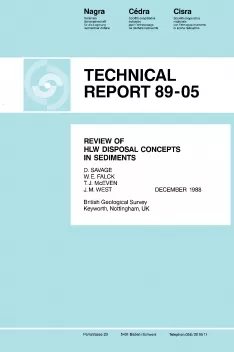
Technical Report NTB 89-05
Review of HLW disposal concepts in sediments
A review of research relevant to the disposal of high-level radioactive waste carried out in North America and Europe in argillaceous rocks has been performed on behalf of the Swiss National Cooperative for the Storage of Radioactive Waste (Nagra). This review includes information published up to the end of 1987.
A list of all sedimentary formations (excluding evaporites) considered as host rocks for radioactive wastes in Belgium, West Germany, France, the UK, Italy, the USA, and Canada is presented and the key aspects of research in specific formations in these countries are described. Topics covered include: site selection and investigation methodology, hydrogeology, transport behaviour (radionuclide migration), hydrochemistry, mineralogy-geochemistry, geotechnical problems, thermal effects and engineered barriers. Formations described include: the Boom Clay (Belgium), the sedimentary sequence at Konrad (West Germany), the sedimentary sequences overlying salt deposits at Asse and Gorleben (both West Germany), various formations in France, the Harwell Research Site and various NIREX sites in the UK, various clay formations in Italy and numerous basins in the USA and Canada.
Generic information on argillaceous strata pertinent to waste isolation is also presented. This includes descriptions of the geochemistry of shales and mudstones, physicochemical transport processes in clays, geotechnical aspects of argillaceous rocks, redox potentials in natural systems, the influences of fractures and faults on the permeability of clays and the geomicrobiology of sedimentary rocks.
Recommendations for further research designed to improve knowledge of critical problems are presented.
A comprehensive reference list is included at the end of the text.
Sorption parameters for the critical radionuclides and a reference list on this topic are given in the appendices.
